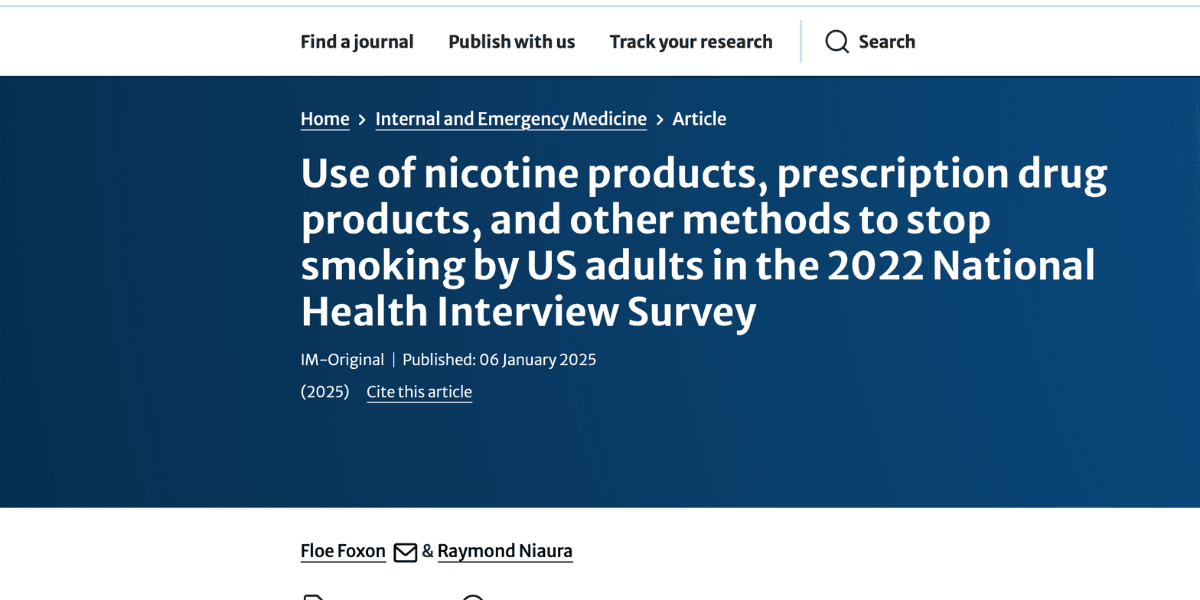Recent findings from a new study analyzing data from the 2022 National Health Interview Survey provide valuable insights into smoking cessation methods among U.S. adults. With approximately 2.9 million individuals successfully quitting smoking for at least six months in the past year, the study highlights the growing reliance on nicotine products, particularly e-cigarettes, as a primary aid.
The most commonly reported listed methods were nicotine products (53.9%, 1.5 million US adults), primarily e-cigarettes used alone or in combination with other methods (40.8%, 1.2 million US adults). The least commonly reported listed methods were non-nicotine, non-prescription drug methods (including a quit line, counseling or clinic, class, or group; 6.3%, 0.2 million US adults).

However, a significant portion of adults still attempt to quit unaided, emphasizing the need for targeted interventions and promotion of evidence-based methods.
To better understand the scope and significance of the data collected, the CoEHAR team reports here the summary of the results of the study conducted by dr. Floe Foxon, Pinney Associates, expert in tobacco harm reduction policies. Below, the interview conducted by the journalists of LIAF Magazine.
What are the most significant findings from the survey “Use of nicotine products, prescription drug products, and other methods to stop smoking by US adults in the 2022 National Health Interview Survey“?
We used data from the US CDC’s National Health Interview Survey (NHIS), which asked adults who either stopped smoking completely (for at least six months) or who tried to quit in the last year which methods (if any) they used to stop/try. We found that 2.9 million US adults stopped smoking in 2022, and that nicotine products, including gum/lozenges, patches, and especially e-cigarettes, were by far the most commonly-reported methods used to stop smoking of the methods surveyed in NHIS; more than half of those 2.9 million who stopped smoking completely used nicotine products to stop, and more than a quarter used just e-cigarettes and no other surveyed method.
This translates to 1.5 million US adults who stopped smoking circa 2022 with nicotine products, and 0.7 million who stopped with e-cigarettes alone. By comparison, prescription drug products and non-nicotine, non-prescription-drug methods were much less popular; approximately 8% of those who stopped smoking completely used prescription drugs, and approximately 6% of those who stopped smoking completely used non-nicotine, non-prescription-drug methods. Still, these methods helped for some adults. We also found that compared to the 13.1 million adults who tried but did not stop smoking, the 2.9 million who did stop smoking were more likely to be younger and to use e-cigarettes to stop, though associations may be mediated by other factors such as barriers to access.

The results suggest that certain populations struggle more with quitting. In your opinion, why do individuals with less emotional stability find it harder to stop smoking?
I’m not a psychologist, but there is some scientific evidence to suggest that some people who smoke do so as a kind of “self-medication”, using nicotine to regulate attentional and emotional dysfunctions (see for example Gehricke at al. 2007 in N&TR for discussion). To be clear, that is not to say that smoking is healthy; just that some individuals who smoke experience certain perceived benefits from doing so, though these benefits do not outweigh the risks of smoking. In our study, we found that the prevalence of none/minimal severity depressive symptoms was higher among the general US population than among adults who tried but didn’t stop smoking. It may be that individuals who suffer more from depression and related mental states find it difficult to stop smoking because removing nicotine deprives them of some sort of mental reprieve. Lower-risk nicotine products may be especially effective for stopping smoking among such adults. But I am only speculating…
In your view, how should smoking cessation centers be structured to effectively reach vulnerable populations?
As I write this, the US Food and Drug Administration’s Center for Tobacco Products just authorized the marketing of 20 nicotine pouch products, including flavoured pouches, as ‘appropriate for the protection of public health’ (APPH). This is in addition to 50 e-cigarette, heat-not-burn, and snus products in tobacco and mint/menthol flavors that were previously authorized as APPH. Based on the findings of our study that reduced-risk products are the most popular aids to stop smoking, I think smoking cessation efforts in the US should put more emphasis on switching to less harmful products.
Do you believe high cigarette prices can serve as a deterrent? Or are additional measures needed to help people quit smoking?
There is scientific evidence that increasing the price of cigarettes acts as a barrier to access to smoking for some individuals, to an extent. However (and I didn’t appreciate this perspective until I heard Emeritus Professor Robert Beaglehole, the chair of Action on Smoking and Health [ASH] in New Zealand talk about it), such taxes are ‘regressive’ for those who don’t quit, in that lower-income adults who smoke will spend a greater proportion of their income on higher-tax cigarettes than will higher-income adults who smoke.
The result is that while some adults will quit smoking after a cigarette price increase, others who can’t or won’t stop will simply lose more of their income, which could mean less food on the table for themselves and their children, less financial security, and generally lower living standards. This is something that really concerns me, that higher prices will punish people who smoke- who in general are already living with lower quality of life- for something they can’t help, because of their dependence on cigarettes. In general, I am not an advocate of the ‘quit or die’ mentality. I think there is a moral argument to be made that first making other methods of stopping smoking, including nicotine products, prescription drugs, and non-nicotine, non-prescription-drug methods more widely available, is a more ethical alternative to potentially making people who already struggle financially struggle even more. We know that cigarettes and e-cigarettes are economic substitutes with cross-price elasticity such that an increase in cigarette price is associated with increased demand for e-cigarettes. The effect of price increases (e.g. through increased taxation) on combustible tobacco can therefore be maximized by making e-cigarettes and other less harmful products available as substitutes.




